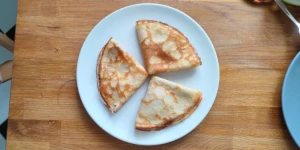
Naleśniki - Polish Pancakes
Jump to recipe
Polish pancakes are one of the most popular dishes of Polish cuisine, which also have their counterparts in other countries. They are a flavorful and adaptable dish that can be enjoyed at any time of the day, whether it's for breakfast, lunch, dessert, or as a delightful snack option.
The Origins of Naleśniki
Although each culture modified the recipe in its way, the first records of pancakes come from ancient Greece. Cratinos, a comedy writer who created four centuries before Christ, described in one of his works cakes similar to pancakes. While there were quite a few dishes back then that resembled this dish, they were far from what they are today.
Pancakes have been known for centuries in Poland and are considered one of the traditional dishes. In Poland, pancakes would originally be a kind of pancake baked on a grate - "na lěsě" (e.g. suspended over a fire or placed under or next to a hearth). You can also find references to it being a cake baked "on a leaf" ( "na leśnik" ). A similar term is also found in other Slavic languages, such as the Czech "nálesník" which is "bread baked on a leaf", Ukrainian налисник - in general language simply "pancake". Over time, the recipe and the method of preparation have changed. Today, pancakes are closer to the French version, known as "crêpes".
The first references to the modern recipe can be found in one of the first Polish cookbooks, which was "Compendium Ferculorum" published in 1672 and since then pancakes have been a permanent element of the Polish diet.
How to prepare Naleśniki
The preparation is very simple and does not require complicated ingredients. In many recipes, you can find a recommendation to let the dough rest for some time, thanks to which the final pancake will not be rubbery.
The problem may be the even distribution of the dough over the entire surface of the pan. However, there is a way. After placing the right amount of batter in the pan, tilt it quickly so that the liquid starts to flow towards the edges, and then tilt it around the central axis of the pan so that the batter fills the entire surface. During this activity, the angle of inclination should be reduced so that you end up with the pan set horizontally.
Recipe informations:
Ingredients
- 1 cup of milk
- 1 glass of water (can be carbonated mineral)
- 25 grams of flour
- 2 eggs
- a pinch of salt and sugar
- 3 tablespoons of oil
- frying oil
